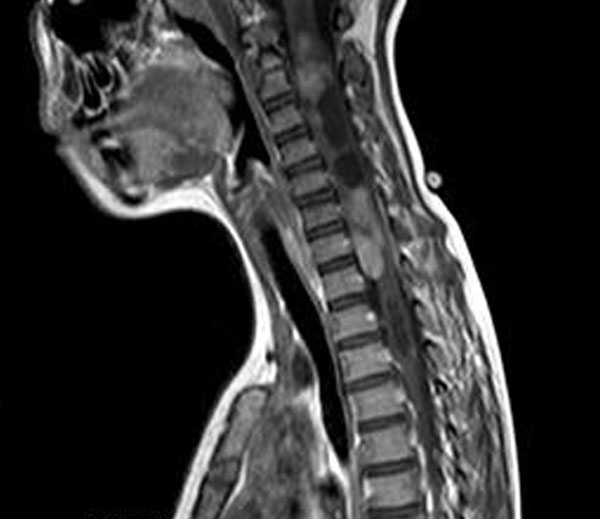The Signs and Symptoms of Spinal Cord Tumors in Children
 Together, the brain and the spinal cord—the sensitive column of nerve cells inside the vertebrae of the spine—make up our central nervous system (CNS). Cancers of the central nervous system, more commonly called brain and spinal cord tumors, are the second-most common form of cancer in children, after leukemia. Statistically, brain tumors and spinal cord tumors are often grouped together; however in reality, there are a number of different types of tumors of the brain and the spinal cord, each of which requires a unique treatment approach and carries its own prognosis (outlook).
Together, the brain and the spinal cord—the sensitive column of nerve cells inside the vertebrae of the spine—make up our central nervous system (CNS). Cancers of the central nervous system, more commonly called brain and spinal cord tumors, are the second-most common form of cancer in children, after leukemia. Statistically, brain tumors and spinal cord tumors are often grouped together; however in reality, there are a number of different types of tumors of the brain and the spinal cord, each of which requires a unique treatment approach and carries its own prognosis (outlook).
Usually, abnormal cell growths like tumors are classified as malignant (cancerous) or benign (non-cancerous). This distinction is significantly less important for spinal cord tumors because (1) spinal cord tumors rarely spread into other systems like other malignant cancers and (2) malignant and benign tumors can be equally life-threatening. Whether benign or malignant, as the tumor grows, it places pressure on and potentially restricts critical tissues of the CNS. Thus, both malignant and benign tumors can cause similar symptoms and require an aggressive treatment approach.
Symptoms and Early Detection of Spinal Cord Tumors
Unfortunately, as with other types of childhood cancer, early detection of a spinal cord tumor is generally not possible. Unlike with some common adult cancers, there are no screenings or testing options to detect the early growth of a tumor within the spinal cord. For most children, detection and diagnosis come only after the tumor has grown large enough to interfere with the normal functioning of the CNS and begin causing noticeable symptoms.
Symptoms of a spinal cord tumor can—and often do—vary widely from child to child. Specific symptoms will depend heavily on where the tumor is growing along the spinal cord, how much it is pressing on and restricting otherwise healthy nerves and tissues, how quickly it is growing, and the age and development of the child. However, some of the most common signs of a spinal cord tumor may be issues such as:
- Pain in the back or neck
- Pain spreading from the back towards the arms and/or legs
- Sciatica
- Numbness, weakness, and or tingling in the extremities, particularly the legs
- Changes to urination or bowel habits
- Difficulty walking
- Partial paralysis
- Spinal deformity
- Delay in reaching growth and development milestones such as sitting or walking
Spinal cord tumors in children are extremely rare, and many of these symptoms are also symptoms of common childhood ailments. However, if you notice these or other unusual health problems in your child, it is important to have your child checked by a pediatrician without delay. If your child’s pediatrician believes that these symptoms may be caused by a spinal cord tumor, he or she will refer you and your child to a neurologist and/or an oncologist for additional testing to ensure a prompt and accurate diagnosis.
More about Childhood Spinal Cord Tumor Cancers:
- About Childhood Spinal Cord Tumor Cancer – Detection and Diagnosis
- Causes, Risk Factors, and Prevention of Childhood Spinal Cord Tumor Cancer
- What are the signs and symptoms of Childhood Spinal Cord Tumor Cancer?
- Spinal Cord Tumor Cancer Treatment
- Spinal Cord Tumor Cancer – Stages and Prognosis
- What is the expected life span of Childhood Spinal Cord Tumor Cancer?
- After Treatment – Living as a Childhood Spinal Cord Tumor Cancer Survivor
Learn More About the Different Types of Childhood Cancers:
- Childhood Brain Tumor Cancer (Brain Stem Tumors)
- Spinal Cord Tumor Cancer
- Childhood Neuroblastoma Cancers
- Childhood Hodgkin Lymphoma Cancers
- Non-Hodgkin Lymphoma Cancers
- Wilms tumor (Kidney Tumors)
- Rhabdomyosarcoma
- Retinoblastoma
- Bone cancer (including osteosarcoma and Ewing sarcoma)
- Leukemia Cancers: Acute lymphocytic (lymphoblastic) leukemia (ALL) Acute myelogenous leukemia (AML); Juvenile myelomonocytic leukemia (JMML)
- Hepatoblastoma (Liver Cancer)
- Rhabdoid Tumors
Together, we can make a difference.
Donate today because kids can’t fight cancer alone®.
About American Childhood Cancer Organization
The American Childhood Cancer Organization was founded in 1970 by parents of children and adolescents diagnosed with cancer. As the nation’s oldest and largest grassroots organization dedicated to childhood cancer, ACCO is committed to shaping policy, supporting research, raising awareness, and providing free educational resources to kids with cancer, survivors, and their families. Additionally, ACCO is the sole U.S. member of Childhood Cancer International (CCI) and has helped support more than half a million families over the past 50 years. Help make childhood cancer a national health priority because kids can’t fight cancer alone®.
For more information about how ACCO can help your family, call 855.858.2226 or visit:



